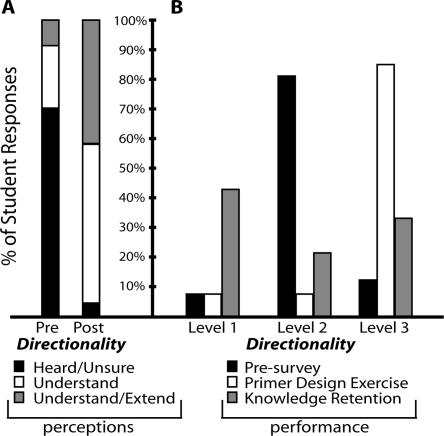Figure 3.
Student Learning Gains: directionality in primer design. (A) Students' perception of understanding about directionality of DNA. Columns represent student responses in pre- and postsurveys. ■, heard of the topic but unsure of the contextual meaning; □, understand the topic in the context of PCR;  , understand the topic and can extend understanding to other contexts. (B) Learning gains and knowledge retention. Students were asked on a presurvey to write the reverse complement of a DNA sequence and indicate directionality. As part of the Primer Design Exercise they had to create a primer that was the reverse complement of a DNA sequence and indicate directionality. Five months after completion of the unit, students were again asked to design a reverse primer for a DNA sequence and indicate proper directionality. Student understanding was ranked according to the rubric depicted in Table 2. All responses are presented as a percentage of total responses (n = 97).
, understand the topic and can extend understanding to other contexts. (B) Learning gains and knowledge retention. Students were asked on a presurvey to write the reverse complement of a DNA sequence and indicate directionality. As part of the Primer Design Exercise they had to create a primer that was the reverse complement of a DNA sequence and indicate directionality. Five months after completion of the unit, students were again asked to design a reverse primer for a DNA sequence and indicate proper directionality. Student understanding was ranked according to the rubric depicted in Table 2. All responses are presented as a percentage of total responses (n = 97).

